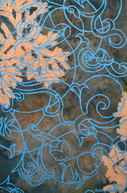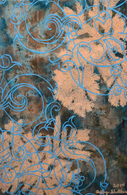Inheritance Series
|
Ap+Ap+ SnS_ SvS_ No. 1, SnS_ SvS_ No. 1, ApAp_ No. 2
12" x 18” (each)
acrylic 2014 |
Fig. 14 Inheritance Series
12” x 18” graphite 2014 |
Sometimes, a spotted horse will be born to two seemingly solid parents. Here is how that could happen. The horse on the left does not have the spotting factor. It has solid skin pigmentation, brown sclera, and solid hooves. It does have two spotting modifiers that are not expressed. The horse on the right has the spotting factor, but no modifiers. To complicate things, the horse on the right has three white feet, leaving only one striped. It has a large blaze, so its skin is not mottled on its face, and sometimes horses with large blazes have white sclera. So the three characteristics associated with the spotting factor are partially or totally hidden. It could be easy to think this is a solid horse. The horse in the center is the offspring of these two horses. It’s an appaloosa with snowflake and varnish. It got the spotting factor from one parent and two modifiers from the other parent (Gower, 107).
Gower, Jeanette. Horse Color Explained a Breeder's Perspective. North Pomfret, VT: Trafalgar Square, 1999. Print.
Gower, Jeanette. Horse Color Explained a Breeder's Perspective. North Pomfret, VT: Trafalgar Square, 1999. Print.




